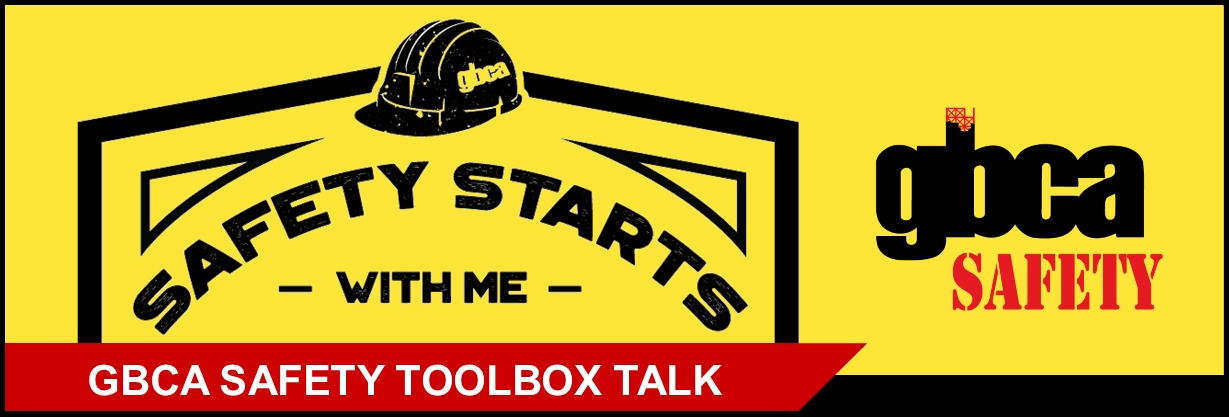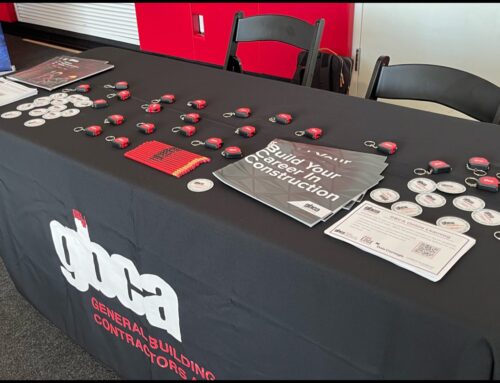This GBCA Safety Toolbox Talk discusses fall hazards that are weather-related and are especially present in cold weather. This toolbox talk also provides tips on how avoid falling on slippery surfaces such as ice. Click below to download the Toolbox Talk as a handout (includes Sign-In Sheet).
Weather-Related Falls
Especially in cold weather, workers need to pay special attention to where you’re walking. Walkways can become slippery due to wet weather, ice, snow, or wetness due to melting ice and snow.
A walkway or sidewalk cleared of snow, or looks like it has been salted, can still be a fall hazard. Black ice, dew, fog, and water vapor can form in a thin layer on just about any surface, creating an almost unseen fall hazard. Sometimes they are visible as wet spots on surfaces, and show up in the early mornings or shaded areas that see little sunlight. Again, cold weather increases the frequency of slippery surfaces.
Ten Tips to Avoid Falling on Slippery Surfaces, Especially in Cold Weather
- Pay attention and watch your step!
- Wear appropriate footwear with soles in good condition.
- Bend your knees a little when walking to increase your body’s stability. This can increase your traction and reduce your chance of falling. (Keep reading this toolbox talk for more in-depth tips for walking on slippery surfaces.)
- Take shorter steps and walk with a slower gait. This will allow you more time to adjust to changing traction conditions.
- Avoid overloading when carrying items. Heavy items may challenge your sense of balance. Ask for help to carry heavy or awkwardly shaped items. Use tools, such as a hand truck, to carry items if required.
- When entering a building, remove as much snow, dirt, and moisture from your shoes as possible.
- If your building entrance is slippery, take the necessary steps to get it cleaned up, protecting you and your fellow workers from falling.
- Use handrails when climbing stairs.
- Take special care when entering and exiting automobiles; use the vehicle for support.
- Avoid rushing around. Plan ahead and try to leave a little earlier so that you can walk without distraction.
Walking on Slippery Surfaces
Especially when walking on ice, think about shuffling, rather than walking. One way to approach it is to “walk like a penguin” on the ice or slippery surface. This will help keep the body more stable.
How to “Walk Like a Penguin”
- Go slow. On a slippery surface like ice, it’s more important to get to your destination safely than quickly.
- Point your feet out at a slight angle (like a penguin!).
- Bend your knees slightly and walk flat-footed, with the entire bottom of your foot hitting the surface at once (i.e. not heel to toe).
- Shuffle your feet and/or take short steps.
- Keep your center of gravity over your feet.
- Watch where you are stepping.
- Concentrate on keeping your balance.
- Keep your arms at your sides and hands out of your pockets.
Protect Yourself If You Fall
When walking on slippery surfaces (and in general on the job site), DO NOT walk with your hands in your pockets. This limits your ability to react and move quickly. In the case of a fall, this can lead to much greater injury.
Should you fall, try to keep the following tips in mind to minimize injury, and especially to protect your head:
- If you feel yourself beginning to fall, tuck your chin against your chest to prevent your head from hitting the ice or pavement.
- Cradle your arms around your head.
- As you fall, try to fold your body into itself, which helps to decrease the height of the fall.
- If you feel yourself fall backwards, bend your knees and curve your spine to roll when you hit the ground.
- As you hit the ground, exhale sharply to tense up your body and allow for it to absorb the impact.
- Never try breaking a fall by using your hands. This will likely only result in a sprain or a break.
Remember to record the attendees of your toolbox talk!
Access GBCA’s full library of toolbox talks:





